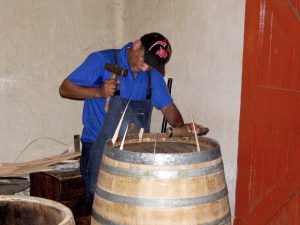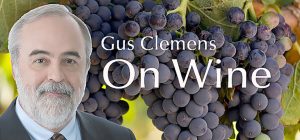It takes two to four centuries to grow the oak tree for a wine barrel. Then, after tree harvest, four, usually more, years to season the wood and the staves. Finally, it is time to turn the staves into a wine barrel.
Staves are planed into the correct shape, tapered and beveled to fit exactly together. A master cooper—the barrel maker—arranges 30-32 staves in a circle held together by temporary hoops. At this point, the future barrel resembles a flower with the bottom of the staves together and the tops splayed out.
The “flower” then is toasted over an open oak fire and sprayed with water to soften the wood and make it pliable. A cable system draws the splayed ends together to create the iconic barrel shape, with very careful attention to the grain of the wood.
The basic barrel shape then is “toasted” over an oak fire to develop flavors and aromas. This is a key part of the operation. The amount of the flame—light, medium, or strong—determines the character of the barrel. Low toasting emphasizes fresh fruit and elegance, while strong toasting delivers smoke, coffee, vanilla, crème brûlée, butterscotch, meats, and other flavors.

At the same time, heavy toast makes for silkier, softer tannins because heavy toast breaks down the oak tannins. Smoke is another characteristic of heavy toasting. Heavy toast is often used for big, bold red wines that can stand up to the oak influence. Heavy toast also can require longer aging for the flavors to integrate and add complexity to the wine.
In addition to how the barrels are treated, the type of oak also influences the wine. French oak produces a more subtle and delicate influence, but more tannin structure and mouthfeel. American oak imparts flavors more quickly and adds roasted coffee, coconut, sweet spice and more robust oak.
French, American, and eastern European oak all contribute oak nuances. The different origins of the oak deliver various levels of the oak influence.
The bottom line is wine is an agricultural product—grapes and wood. It also is the work of human hands and experienced minds.
Tasting notes
• Funckenhausen Malbec Blend, Mendoza, Argentina 2022: Vibrant, juicy full-bodied malbec-led blend. Argentine wine with hint of German heritage. $12-16 (1-liter bottle) Link to my review
• The Prisoner Wine Company Saldo Red Blend 2019: Dependable celebration of ripe zin with supporting cast. Big, powerful, not quite as high alcohol as previous vintages, but still up there are 15% ABV. $32 Link to my review
Last round: A pregnant woman began shouting: “Couldn’t, wouldn’t, shouldn’t, didn’t, can’t, don’t!” She obviously was having contractions. Wine time.

